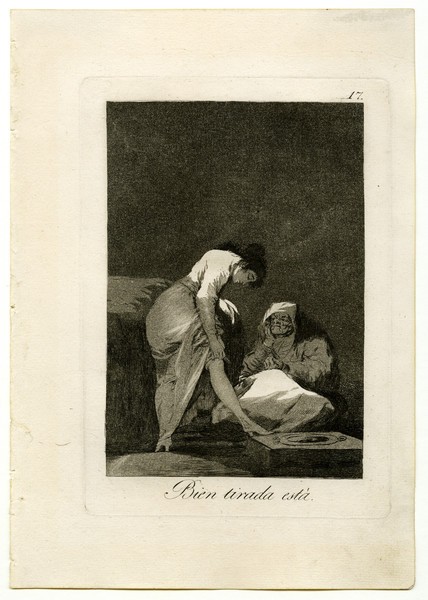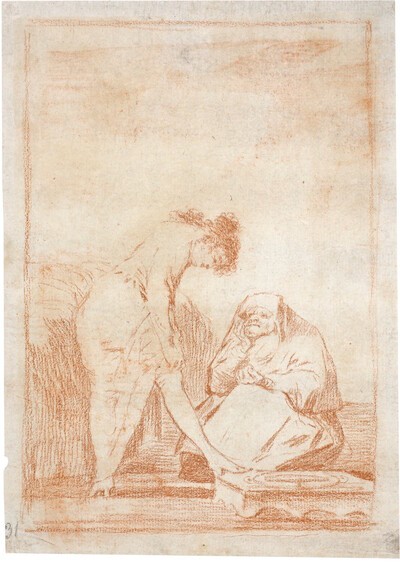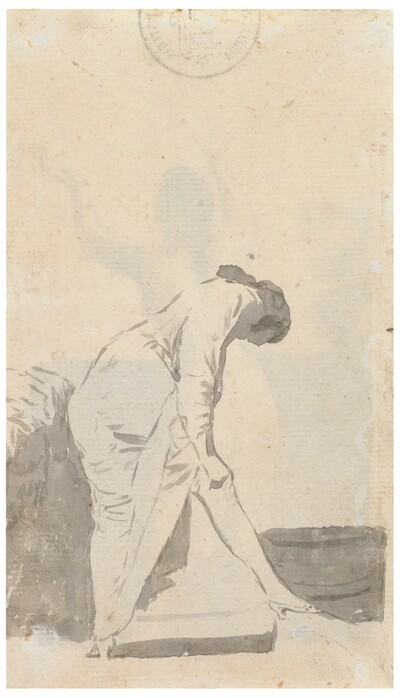- Cronología
- Ca. 1797 - 1799
- Dimensiones
- 219 x 153 mm
- Técnica y soporte
- Aguafuerte, aguatinta bruñida y buril (prueba de estado antes de bruñir el aguatinta)
- Reconocimiento de la autoría de Goya
- Undisputed work
- Ficha: realización/revisión
- 25 Nov 2010 / 29 May 2024
- Inventario
- 225
Well thrown is (at the bottom)
17. (in the upper right-hand corner)
See Francisco de Goya y Lucientes, Painter.
Two state proofs are known to exist with the title in pen manuscript, one of them written crudely and the other in careful calligraphy for the letter engraver. In both the word "está" is accented, although the accent disappeared when it was transferred to copperplate and was added after a few printings when the error was realised.
Two preparatory drawings for this engraving have survived (1) and (2).
In the centre of the print, a young woman pulls up the stocking covering her leg, which we can see up to the knee. She leans on the bed and places her foot on a brazier. All this takes place under the gaze of a completely covered old woman, of whom we can only see her aged face. This situation is taking place in a dark environment in which the light is concentrated on the young woman's light-coloured clothes and on the top of the old woman's head.
Ayala's manuscript explains this scene by saying that "there can be nothing more thrown down than a harlot. Aunt Curra knows very well how to stretch her stockings". In the Prado Museum's manuscript it is commented that "Aunt Curra is no fool. She knows very well that it is good for stockings to be well stretched". Finally, the manuscript in the National Library states that "a prostitute stretches her stocking to show off her beautiful leg, and there is nothing more flimsy than her".
In this case Goya has played on the double meaning of the title to criticise prostitution, which became a common practice by which young women were able to prosper economically. The painter openly declares his view of prostitution as a practice that diminishes women's dignity.
This image must have inspired Charles Baudelaire (Paris, 1821-Paris, 1867) in Les Phares from Les fleurs du mal (1857), as well as an article on Goya in which he says: "(...) these white and slender Spaniards who wash and groom themselves with old sempiternas for the sabat and for prostitution at night, sabat of civilisation".
This engraving by Goya is clearly reminiscent of the print In the Tavern by William Hogarth (London, 1697-1764) in which a prostitute on the right-hand side of the print pulls up a stocking. In this case the bustling atmosphere of the brothel differs from the more intimate scene depicted by the Aragonese painter, although the attitude of the women is very similar in both cases.
It should also be noted that with this type of image Goya advocates the scenes of the life of prostitutes painted by Henri Toulouse-Lautrec (Albi, 1864-Malromé, 1901). Both were concerned with capturing the intimacy of these women, although in the case of the French painter his works are free of any criticism.
The plate is preserved in the National Chalcography (no. 188).
-
Goya. Gemälde Zeichnungen. Graphik. TapisserienKunsthalle BaselBasle1953from January 23th to April 12th 1953cat. 209
-
De grafiek van GoyaRijksmuseum RijksprentenkabinetAmsterdam1970from November 13th 1970 to January 17th 1971cat. 22
-
El arte de GoyaMuseo de Arte Occidental de TokioTokyo1971from 16th 1971 to January 23th 1972. Exhibited also at the Kyoto Municipal Museum of Art, January 29th to March 15th 1972.cat. 62
-
Goya. La década de Los CaprichosMadrid1992organized by Real Academia de Bellas Artes de San Fernando sponsored by Fundación Central Hispano, Madrid, consultant editor Nigel Glendinnig. From October 26th 1992 to January 10th 1993cat. 83
-
GoyaNationalmuseumStockholm1994consultant editors Juan J. Luna and Görel Cavalli-Björkman. From October 7th 1994 to January 8th 1995cat. 57
-
Francisco de GoyaMuseo d'Arte ModernaLugano1996exhibition celebrated from September 22nd to November 17th.cat. 17, p.44
-
Francisco Goya. Sein leben im spiegel der graphik. Fuendetodos 1746-1828 Bordeaux. 1746-1996Galerie KornfeldBern1996from November 21st 1996 to January 1997cat. 23
-
Goya artista de su tiempo y Goya artista únicoThe National Museum of Western ArtTokyo1999from December 1st to July 3th 1999cat. 110
-
Goya e la tradizione italianaFondazione Magnani RoccaMamiano di Traversetolo (Parma)2006consultant editors Fred Licht and Simona Tosini Pizzetti. From September 9th to December 3th 2006cat. 17, p. 150
-
Goya. Opera graficaPinacoteca del Castello di San GiorgioLegnano2006exhibition celebrated from December 16th 2006 to April 1st 2007p.27
-
Goya luces y sombrasCaixaForumBarcelona2012consultant editors José Manuel Matilla and Manuela B. Marqués. From March 16th to June 24th 2012cat. 19
-
Goya et la modernitéPinacothèque de ParisParís2013from October 11st 2013 to March 16th 2014cat. 182
-
Expérience GoyaLille2021cat. 40
-
2022
-
Goya engravings and lithographs, vol. I y II.OxfordBruno Cassirer1964p.87, cat. 52
-
Vie et ouvre de Francisco de GoyaParísOffice du livre1970p.178, cat. 485
-
Goya, la década de los caprichos: dibujos y aguafuertesMadridReal Academia de Bellas Artes de San Fernando1992pp.140-141, cat. 83
-
Catálogo de las estampas de Goya en la Biblioteca NacionalMadridMinisterio de Educación y Cultura, Biblioteca Nacional1996p.82, cat. 105
-
El libro de los caprichos: dos siglos de interpretaciones (1799-1999). Catálogo de los dibujos, pruebas de estado, láminas de cobre y estampas de la primera ediciónMadridMuseo Nacional del Prado1999pp.182-183
-
ParísPinacoteca de París2013p. 248
-
Goya. In the Norton Simon MuseumPasadenaNorton Simon Museum2016pp. 42-75
-
Expérience Goya (cat. expo)LilleRéunion des Musées Nationaux2021p. 90
-
Museo de Bellas Artes de Badajoz y Diputación de Badajoz2022p. 35


